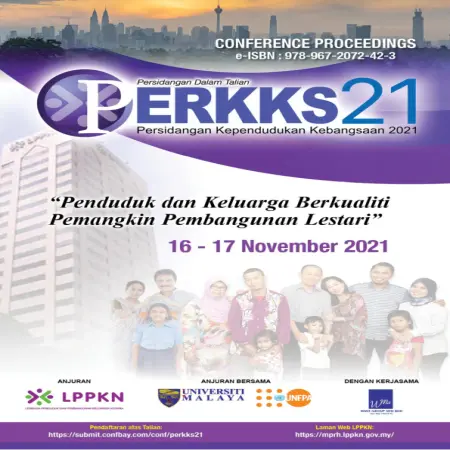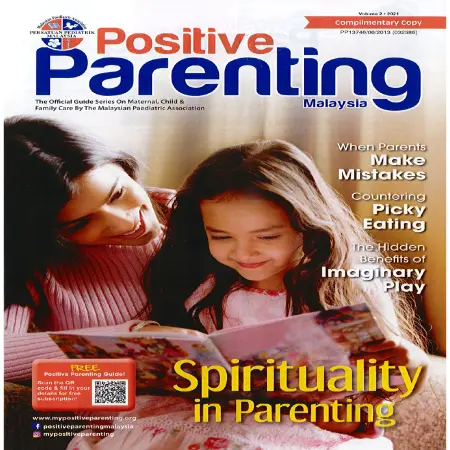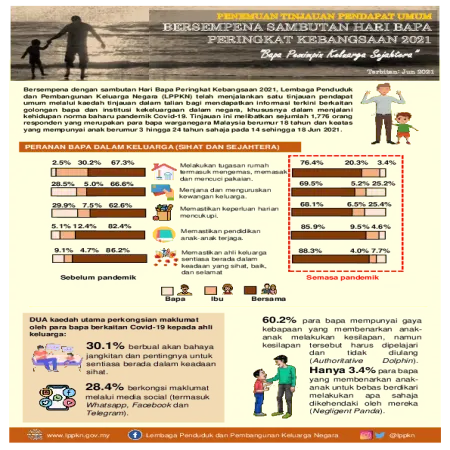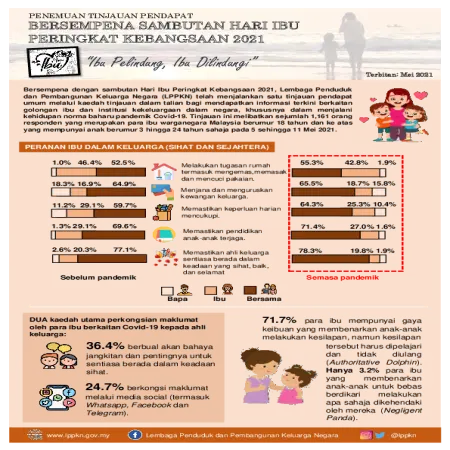PUBLICATIONS
|
|
Cabaran kesejahteraan suri rumah berpendidikan tinggi
Item Type: Article
Editor:
Year: 00/12/2021
Abstract: Highly educated women have crossed the mainstream by choosing housewife as a preferred career over a professional career. This step was taken as a solution to the problems of the household, a solution to the weakness of the childcare center and a preparation of children’s ability to meet the demands of a challenging world. This difficult decision was made as a struggle and investment of time to develop human capital as a national development asset. This conceptual paper uses library review techniques to understand and identify the challenges faced by highly educated housewives in developing well-being in life. Suggestions for developing the well-being of housewives are also discussed.
|
|
|
|
|
|
Empowering single mothers through institutional support: lessons from single mothers in Sabah
Item Type: Article
Editor:
Year: 00/12/2021
Abstract: Life can be challenging for single mothers. They are viewed as the most vulnerable social groups in society who often lack educational attainment, skills and social networks; thus, limiting their opportunities to compete in the labour market. Consequently, single mothers struggle to achieve financial independence and to support the well-being of their family. To help single mothers build a better life, it is crucial to provide single mothers with solid institutional support programmes. This paper explores the extent to which the institutional support programmes designed for single mothers are in accordance with the needs and expectation of the single mothers in Sabah. The views obtained from the leaders of the single mother associations show that the support programmes are useful for single mothers; however, the programmes are still inadequate to lift them out of poverty. Suggestions for improvement of the institutional support programmes for single mothers are highlighted.
|
|
|
|
|
|
Pengukuhan capaian vaksinasi HPV melalui perkhidmatan di Klinik Nur Sejahtera LPPKN: Suatu gambaran umum
Item Type: Book Section
Editor:
Year: 01/12/2021
Abstract: In Malaysia, Cervical Cancer remains among the top three most common cancers among women aged 15 to 44 years. Although the Malaysian Ministry of Health (MOH) has developed the Human Papillomavirus (HPV) Vaccination Program since 2007, the level of vaccination reach involving target groups in the country is still at a moderate level and not yet comprehensive. In support of efforts to ensure women’s reproductive health and well-being, the National Population and Family Development Board (NPFDB), an agency under the Ministry of Women, Family and Community Development has implemented an HPV vaccination program through Klinik Nur Sejahtera (KNS) nationwide.
|
|
|
|
|
|
Pencetus utama konflik perkahwinan sepanjang fasa pertama perkahwinan dalam kalangan pasangan muda: Kajian kes semasa Perintah Kawalan Pergerakan (PKP)
Item Type: Book Section
Editor:
Year: 01/12/2021
Abstract: The first phase of marriage is often associated with a crisis phase, an adjustment phase and a stress phase. The success of the young couple through this phase will ensure the stability of the marriage and the survival of the family institution. Divorce is a major threat to young couples in the first phase of marriage. This study aims to identify the triggers of marital conflict during the first phase of marriage (1-10 years) among young couples in the State of Selangor.
|
|
|
|
|
|
Spirituality in parenting
Item Type: Article
Editor:
Year: 01/10/2021
Abstract: The emergence of COVID-19 since last year has cause an unprecendented health crisis across the globe, affecting people physically, mentally, financially and socially. To alleviate the difficulties and stresses in dealing with the pandemic and ensuing lockdowns, multiple approaches have been taken by the governments, institutions and individuals. Spirituality plays a major role in helping some families cope during this extraordinary period. It can serve as an empowering foundation to any collective, the family unit being the most basic example. Indeed, spirituality is an integral component in parenting that should not be overlooked even during normal times.
|
|
|
|
|
|
Correlates and consequences of delayed marriage in Malaysia
Item Type: Article
Editor:
Year: 01/10/2021
Abstract: This paper aims to examine the correlates of age at first marriage and the consequences of late marriage. Data for this paper were drawn from the 2014 Malaysian Population and Family Survey. Simple cross- tabulation and multiple classification analysis were used for the analysis. Age at marriage of women varied across socioeconomic groups.
|
|
|
|
|
|
Penemuan tinjauan pendapat umum bersempena Sambutan Hari Bapa Peringkat Kebangsaan 2021 "Bapa Pemimpin Keluarga Sejahtera"
Item Type: Infographic
Editor:
Year: 00/06/2021
Abstract: The findings of an opinion survey conducted by the National Population and Family Development Board (LPPKN) in conjunction with the National Father's Day 2021 celebration.
|
|
|
|
|
|
Ordinal regression for modelling the family well- being among the Malaysians
Item Type: Article
Editor:
Year: 30/06/2021
Abstract: Understanding factors which affect the level of family well-being is important as it contributes to effective decision making among the policymakers to improve the family lives as well as to strengthen the family institution. This study develops an ordinal regression model which identifies demographic, economic and social factors that are significant in explaining the status of family well-being.
|
|
|
|
|
|
Penemuan tinjauan pendapat bersempena sambutan Hari Ibu Peringkat Kebangsaan 2021 "Ibu Pelindung, Ibu Dilindungi"
Item Type: Infographic
Editor:
Year: 00/05/2021
Abstract: In conjunction with the National Mother's Day 2021 celebration, LPPKN conducted a public opinion poll through online survey. The objective of this study is to obtain the latest information related to mothers and family institutions in the country, especially in living the new norms of the Covid-19 pandemic.
|
|
|
|
|
|
Comparison of rural and urban contraceptive methods preferences among married women in Malaysia, 2018
Item Type: Article
Editor:
Year: 30/05/2021
Abstract: Contraceptive use among women remains an important public health intervention. Imperatively, the equality of family planning access between rural and urban areas allows all women to have the same opportunities to receive family planning service towards better well-being of families.
|
|
|
|














